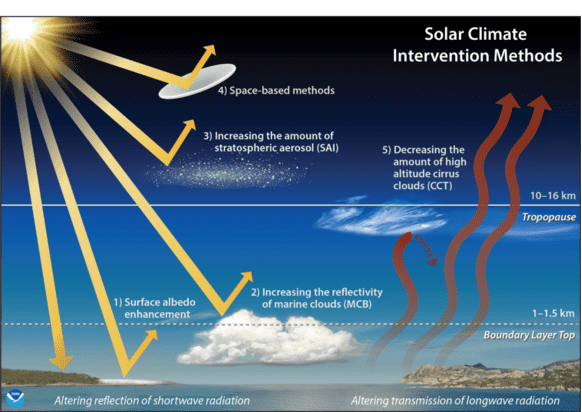The first idea for sustainable energy management (SRM) appeared in 2006. Atmospheric chemistry professor Paul Crutzen discovered that stratospheric injection could be an “escape route” for rising temperatures. This has been an incentive for scientists to look into it carefully. For example, an American research group at Harvard University has developed into an important player in solar geoengineering research.
How does solar radiation management work?
The energy balance between the Earth and the Sun ensures that the Earth has a livable temperature. The Sun emits short-wave radiation, which is partially absorbed by the Earth’s surface and atmosphere. The other part is reflected back into space. The atmosphere and Earth’s surface reflect part of the absorbed heat back to the atmosphere in the form of long-wave radiation. Clouds and greenhouse gases absorb this heat, keeping most of the heat on Earth. The rest is emitted through the atmosphere into space.

Solar radiation modulation (SRM) relies on methods to reflect sunlight. source: NOAA Laboratory of Chemical Sciences
The more radiation is reflected back into space, the lower the Earth’s temperature. SRM uses this principle by reflecting as much radiation as possible. This can be done, among other things, by placing mirrors in the room, making the clouds more reflective, or injecting the stratosphere. Stratospheric injection is the most well-known method. This involves injecting reflective particles into the stratosphere, which could cause the Earth’s temperature to cool. It sounds effective and is very affordable, but there may be a problem.
Pros and Cons
Using stratospheric injection is one way to provide climate crisis relief. On the other hand, little is known about the negative consequences. For example, modifying the radiation balance can affect weather patterns and ecosystems. It is precisely because of these doubts that proponents want more research into solar radiation management. Stratospheric injection may have negative consequences, but without targeted solutions, climate change becomes harmful as well. On the other hand, such a “technical fix” would offer too much hope and distract from cutting emissions, which is the only thing that can really work in combating global warming.
Written by a group of scholars Open letter Addressed to governments and calling for the development and potential use of radiation risk management on a global scale. “Focusing on solar radiation management as a potential future solution could jeopardize mitigation obligations,” the letter states. Governments, companies and communities will not be encouraged to make efforts to reduce carbon dioxide. One risk is that solar radiation management may be used as an argument for postponing CO2 reduction policy.
The physical aspect of research still largely dominates the social and environmental perspectives. In climate science, models are used to find out what happens when certain factors change. Real life is highly unpredictable, and SRM cannot be managed globally in a fair and effective manner. Although research can reveal more about the potential effects, they are one and the same Future ban Solar geoengineering is not unlikely.

“Coffee buff. Twitter fanatic. Tv practitioner. Social media advocate. Pop culture ninja.”










More Stories
Which can cause an increase in nitrogen.
The Central State Real Estate Agency has no additional space to accommodate Ukrainians.
The oystercatcher, the “unlucky national bird,” is increasingly breeding on rooftops.